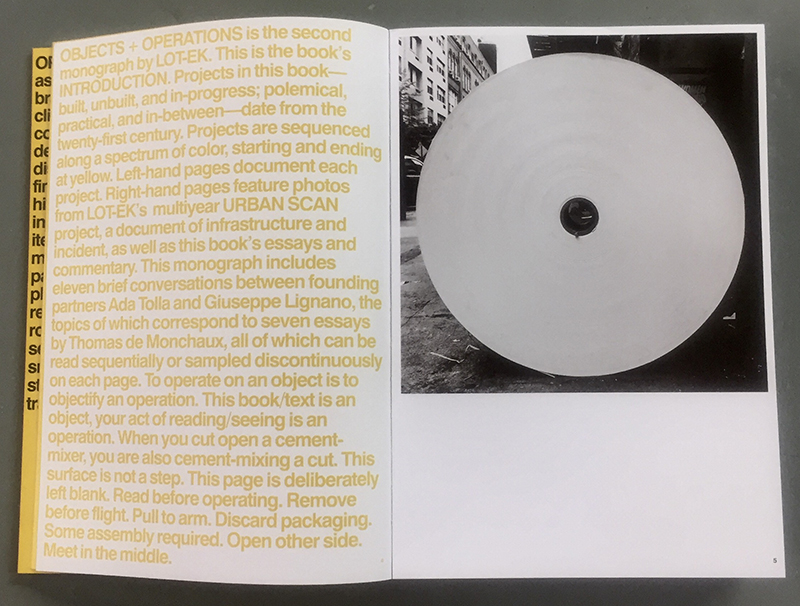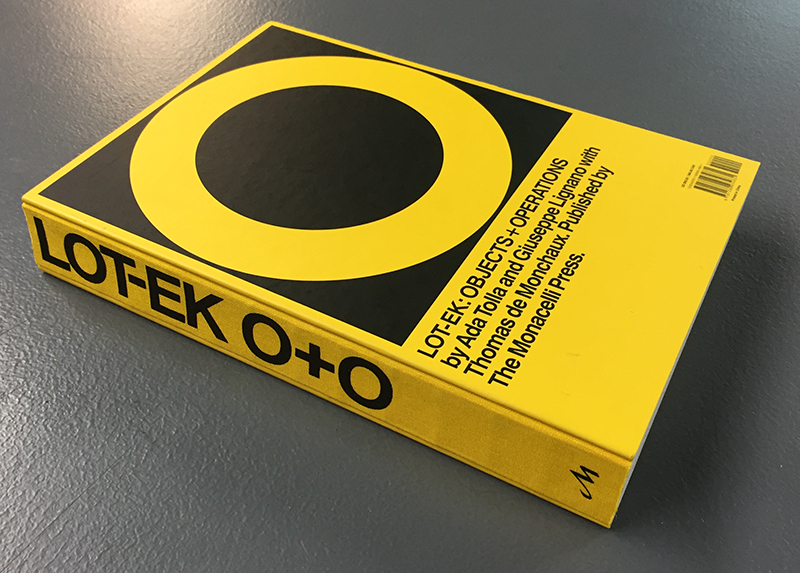
The following is excerpted and adapted from six essays featured in LOT-EK: Objects and Operations, out now from The Monacelli Press and published here with permission from the publisher. — The Editors
“The sky above the port was the color of television, tuned to a dead channel.” That’s the Call me Ishmael of our century. It goes on: “A year here and he still dreamed of cyberspace, hope fading nightly. All the speed he took, all the turns he'd taken and the corners he'd cut in Night City, and still he'd see the matrix in his sleep, bright lattices of logic unfolding across that colorless void.... The Sprawl was a long strange way home over the Pacific now, and he was no console man, no cyberspace cowboy.” There, twice—at first, at last—is that word—cyberspace—coined by William Gibson in his first novel, 1984’s Neuromancer: a dimension of alterity, of computational code visualized as a formal matrix, representing networked information digitally coursing through civilization, vivid and icy and clean. Its material world, on the other hand, is a dark dirty mess: there’s no Wi-Fi, no cell signal, no cloud. In this future, it’s all cables and jacks.
“So I followed Dog and Molly through Lo Tek heaven, jury-rigged and jerry-built from scraps that even Nighttown didn't want.” Neuromancer has its prehistory in William Gibson’s 1981 short story Johnny Mnemonic, which first introduces its neo-Tokyo of The Sprawl, geodesic-domed Nighttown somewhere in there. The hero confronts his enemy who is hiding among the Lo Teks—no hyphen—an outcast band of counter-technological scavengers, at their habitat, a construction suspended far above the city with steel cable that had threaded, “through a junkyard and drawn it all taut. It creaked when it moved, and it moved constantly. Spraybomb graffiti dates back to the turn of the century, gradually thinning until a single name was repeated at intervals. LO TEK. In dripping black capitals. ‘Who's Lo Tek?’ […] ‘Low technique, low technology.’ […] Lo Tek fashion ran to scars and tattoos. And teeth. The electricity they were tapping seemed to be an exception to their overall aesthetic.”

A computer, in the vocabulary of Neuromancer, is a console: specifically, the thing that gets you into cyberspace. The word evokes the heavy vase-like glass cathode-ray tube (CRT) monitor, of the kind that all televisions and computers once incorporated. Inside an evacuated glass envelope—leaded to block carcinogenic X-rays—a gun shoots raster lines of electrons at phosphorous coating the back of that face, traversing the screen 25 times a second, its aim directed by magnetic fields generated by metal coils snaking around the tube’s narrow neck. TV-LITE, an early lighting fixture by the architecture firm LOT-EK, was made of two glass cathode ray televisions, stripped to their tubes, suspended, unwatchable and intimate, face-to-face. Later would come TV TANK, a steel petroleum tractor-trailer tank sliced into screen-watching pods, and and MIXER, a cement-truck-turned-sensory-overload chamber—both projects with the visible backs of the cathode ray tubes protruding from their steel surfaces, ominously and luminously cathode-ray-gunning into their dark interiors. From the backs of these machines, as today from even the sleekest flattest and most formal screens, a formless tangle of wires delivering bits and electrons through an array of tiny metal-lined sockets and inlets. In our radically growing and densifying cities, we like to distinguish between the formal and informal, the formed and formless, the hardware and the code, but even a small-scale project like TV-LITE redirects our attention to the complex space between those imaginary extremes: bridging and blurring screens and wires, fronts and backs, highs and lows, heres and theres. For the places in cities where containers are loaded and unloaded, for the still-physical places in digital networks where connections are made, for the hardware holes in computers, we still use the same word: ports.
Through happenstance, through some kind of New-Yorker-Neopolitan feeling for ports of the urban kind, the founding partners of LOT-EK, Giuseppe Lignano and Ada Tolla got known as the Dog and Molly of the standard steel shipping container. Giuseppe: “There is something about us and steel.” Ada: “Something elemental.” Giuseppe: “But elemental about something artificial, something manufactured.” Ada: “Do we wish that we were never under this spell of the container, and we would have other possibilities?” Giuseppe: “Well, yeah.” Ada: “But, no!” Giuseppe: “But no. The first step is always to manipulate something that was originated for something else.”

In 1996, cyberspace doubled. The number of internet host machines went from 15 to 30 million (with 100 million users, today at 3.5 billion). What was then the largest container vessel, the Regina Maersk, was built in Denmark, for service from Europe to the Far East, the first ship to carry over 3000 typical containers; today the standard capacity is around 6000 and the largest class of container ship carries about 9,000. Visualize the physical internet, with all its undersea cables; visualize global shipping channels. Perhaps the patterns are not so different. 1996 was the year of two breakthrough LOT-EK projects. The Guzman Penthouse in lower midtown Manhattan: the stress-skin panelized trailer of a tractor-trailer truck, lifted to a rooftop. Inside, empty refrigerators, doors removed, hold technology, three television monitors, one polemically turned sideways, to accommodate a surveillance camera angle on the pinnacle of the Empire State Building nearby. The Miller-Jones Studio further downtown: a 1970s Japanese variation on a shipping container, in flat unfinished aluminum, cuts through the space, dividing private from public—but to induce precisely awkward interruptions: the glass television screen but not the bulky cathode ray tube behind. In those projects, the visual noise of wear and tear is left in place. Today, LOT-EK are completing a 75,000-square foot shipping container apartment building in Johannesburg. Now, as then, wherever it doesn’t compromise performance or comfort, all signs of wear are left in place—but precisely cut.
Recycling makes us feel clean. And yet, unlike its logo of three folded arrows, recycling is not a perfect closed circle. Comprehensive lifecycle assessment, factoring the load of the industrial infrastructure required by the actual event of recycling itself, can suggest a marginal effect for the full reversion of objects back to their elemental matter—paper, glass, plastics, ceramics, poly-vinyl-chloride, and especially steel and other metals. An alternative—the practice anticipated in Gibson’s Lo Tek heaven—is upcycling, the operation of adaptively reusing objects: not their reduction back to their constituent material, but the retention of their existing embodied energy and the reoccupation of their existing form, structure, and infrastructures of transport. Objects transformed only by incision and array, and then by the application to which they’re put. A computer, wrote Ada Lovelace—another Ada, the mathematician and historically the first computer programmer, the first neuromancer—already in the Nineteenth Century, “might act upon other things than number, were objects found whose mutual fundament relations could be expressed by those of operations.” Ada: “It helps us to do radical things because we use familiar objects. The object is the bridge to the operation.” Giuseppe: “Because of course to us the container is nothing. It’s nothing. It’s a piece that you start with. It’s between what comes before and after.”
LOT-EK is a 90s band. And in the twenty-year cycle, right on time, the 90s are back. But it’s not just that. Then, as now, we find ourselves pulled between actual and virtual, between what’s on the screen and what’s behind it. Between the ports in cities and the ports in machines. Between what comes before and after. The story I heard is that the original name “LOT/EK” didn’t work as a Hypertext Transfer Protocol World Wide Web address: something about that forward slash, and that someone already owned the sequence with hyphen (joint) where slash (cut) had been: the very name of LOT-EK is an operated object, an ingenious giambarra, an adaptive transformation, addressing a gap between words and deeds; between the world as it is made to seem and the world as it is; between the world as it is and the world as it could be.

